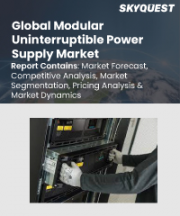
|
시장보고서
상품코드
1715713
세계의 모듈식 UPS 시장 : 컴포넌트, 전력 용량, 구성, 단계, 토폴로지, 유형, 전개, 최종사용자 산업별 - 예측(2025-2030년)Modular UPS Market by Component, Power Capacity, Configuration, Phase, Topology, Type, Deployment, End-User Industry - Global Forecast 2025-2030 |
||||||
모듈식 UPS 시장은 2024년에 60억 6,000만 달러로 평가되었습니다. 2025년에는 64억 5,000만 달러에 이르고, CAGR 6.56%로 성장하여 2030년에는 88억 8,000만 달러에 달할 것으로 예측됩니다.
| 주요 시장 통계 | |
|---|---|
| 기준 연도 : 2024년 | 60억 6,000만 달러 |
| 추정 연도 : 2025년 | 64억 5,000만 달러 |
| 예측 연도 : 2030년 | 88억 8,000만 달러 |
| CAGR(%) | 6.56% |
현대 기업들이 핵심 인프라에 대한 탁월한 복원력과 적응력을 요구함에 따라 전원 공급 시스템의 진화는 매우 중요한 단계에 이르렀습니다. 모듈형 UPS 시장은 정전으로부터 보호할 수 있는 확장성 및 맞춤형 솔루션에 대한 수요 증가에 대응하기 위해 등장했습니다. 첨단 기술과 역동적인 시스템 구성의 통합에 중점을 둔 이 솔루션은 다양한 용도에 대한 안전과 비즈니스 연속성 강화를 제공합니다. 디지털 시스템에 대한 의존도가 높아지고 데이터 집약적인 업무가 증가함에 따라, 전력 공급이 중단될 경우 비즈니스와 재정적으로 큰 타격을 입을 수 있습니다. 각 산업 분야의 기업들이 기술적 발자취를 계속 확장하는 가운데, 모듈형 UPS 시장은 비용과 성능의 균형을 유지하면서 다양한 요구를 충족시키기 위해 조정된 서비스와 솔루션 스펙트럼을 제공함으로써 적응해 왔습니다. 이 보고서에서는 이러한 기술 혁신이 어떻게 업계 동향을 주도하고 기업들이 일상적인 요구와 점점 더 불안정해지는 전력 상황에서의 예기치 못한 도전에 대응할 수 있게 되었는지에 대해 살펴봅니다.
이러한 발전을 촉진하기 위해 전문가와 이해 관계자는 모듈식 UPS 기술의 뉘앙스를 깊이 파고들어 전원 백업 시스템뿐만 아니라 전체 운영 프레임워크를 변화시킬 수 있는 능력을 충분히 이해하도록 권장합니다.
모듈형 UPS 시장의 변화
최근 몇 년 동안 모듈형 UPS 업계는 기술 혁신과 전원 관리 시스템의 효율성에 대한 요구가 높아지면서 시장 역학을 재정의하는 등 격변을 겪고 있습니다. 기존 설계에서 진화한 새로운 모듈식 아키텍처는 뛰어난 확장성, 에너지 효율성 향상, 설치 옵션의 높은 유연성을 제공합니다. 이러한 혁신을 통해 기업들은 고립된 독립형 솔루션에서 다운타임을 최소화하고 성능을 최적화하는 보다 통합적이고 네트워크화된 전원 공급 시스템으로 전환할 수 있게 되었습니다.
하드웨어 및 소프트웨어 구성 요소의 혁신은 모듈형 UPS 시스템을 기존 인프라에 통합하는 방식을 변화시켰으며, 전원 백업 솔루션이 비즈니스 연속성 전략과 긴밀하게 연계될 수 있도록 했습니다. 업계는 또한 경직되고 획일적인 접근 방식에서 개별적인 요구 사항을 충족하는 설계로 패러다임의 전환을 경험했습니다. 그 결과, 이해관계자들은 위험을 예측하고 완화할 수 있게 되었으며, 기술 투자에 대한 안전성을 확보할 수 있게 되었습니다. 또한 디지털 모니터링의 급속한 발전, 예지보전 실천, 신흥 에너지 관리 시스템과의 원활한 통합의 영향을 받아 전력 보증 및 인프라 복원력에 있어서도 변화의 시기를 맞이하고 있습니다.
모듈형 UPS 시장을 형성하는 시장 세분화에 대한 주요 인사이트을 제공합니다.
시장을 자세히 조사하면 모듈형 UPS 산업의 다양한 측면을 분석하는 데 도움이되는 계층 적 세분화 전략이 드러납니다. 주요 세분화 중 하나는 구성 요소에 기반한 것으로, 시장은 서비스와 솔루션을 구분하여 명확한 범주로 조사됩니다. 서비스 측면에서는 통합 및 배치 서비스, 관리형 인프라 서비스, 지원 서비스 등을 고려하고, 솔루션 측면에서는 배터리 모듈, 바이패스 모듈, 제어 모듈, 전력 모듈, 정적 스위치 등을 고려합니다.2. 두 번째 세분화는 전력 용량을 고려한 것으로 100-250kVA, 250-500kVA, 500kVA 이상, 100kVA 미만 등의 범위로 시스템을 평가하여 다양한 전력 수요와 용도 범위에 대응하고 있습니다.
또 다른 중요한 세분화는 랙마운트, 독립형, 타워형 솔루션을 포함한 구성 옵션과 관련된 것으로, 공간 및 확장성 요구사항에 맞는 다양한 폼팩터를 제공합니다. 또한, 전기적 위상 측면에서도 시장을 분석하여 단상 및 3상 셋업을 구분하여 운영 요구 사항을 정확하게 충족할 수 있도록 하고 있습니다. 또한, 토폴로지 세분화는 시스템을 모듈형, 확장형, 독립형으로 분류하여 명확한 이미지를 제공합니다. 유형 기반 세분화에는 라인 인터랙티브, 오프라인/대기, 온라인/이중 전환 시스템이 포함되며, 각각 다른 복원력과 효율성 매개 변수에 따라 세분화됩니다. 클라우드 기반 플랫폼(하이브리드 클라우드, 프라이빗 클라우드, 퍼블릭 클라우드로 분류)과 온프레미스 설치를 모두 포괄하는 배포 전략에 대해서도 비판적으로 분석합니다. 마지막으로, 최종 사용자 산업 세분화는 은행/금융서비스/보험(보험 서비스 및 리테일 뱅킹으로 세분화), 헬스케어(클리닉, 병원, 제약 분석), 산업 제조, IT 및 데이터센터, 소매 환경 등의 부문에 걸쳐 있습니다. 이러한 경쟁적 고찰은 시장 니즈, 기술 개발 궤적, 모듈형 UPS 산업을 지배하는 경쟁 역학을 이해할 수 있는 견고한 프레임워크를 제공합니다.
목차
제1장 서문
제2장 조사 방법
제3장 주요 요약
제4장 시장 개요
제5장 시장 인사이트
- 시장 역학
- 성장 촉진요인
- 성장 억제요인
- 기회
- 해결해야 할 과제
- 시장 세분화 분석
- Porter’s Five Forces 분석
- PESTLE 분석
- 정치
- 경제
- 사회
- 기술
- 법률
- 환경
제6장 모듈식 UPS 시장 : 컴포넌트별
- 서비스
- 통합 및 도입 서비스
- 매니지드 인프라 서비스
- 지원 서비스
- 솔루션
- 배터리 모듈
- 바이패스 모듈
- 제어 모듈
- 파워 모듈
- 정적 스위치
제7장 모듈식 UPS 시장 : 전력 용량별
- 100-250kVA
- 250-500kVA
- 500kVA 이상
- 100kVA 미만
제8장 모듈식 UPS 시장 : 구성별
- 랙 마운트 솔루션
- 스탠드얼론 솔루션
- 타워 솔루션
제9장 모듈식 UPS 시장 : Phase별
- Single-Phase
- Three-Phase
제10장 모듈식 UPS 시장 : 토폴로지별
- Modular
- Scalable
- Stand-Alone
제11장 모듈식 UPS 시장 : 유형별
- 라인 인터랙티브
- 오프라인/스탠바이
- 온라인/더블 전환
제12장 모듈식 UPS 시장 : 전개 형태별
- 클라우드 기반 솔루션
- 하이브리드 클라우드
- 프라이빗 클라우드
- 퍼블릭 클라우드
- 온프레미스
제13장 모듈식 UPS 시장 : 최종사용자 업계별
- 은행/금융서비스/보험
- 보험 서비스
- 소매금융
- 헬스케어
- 클리닉
- 병원
- 의약품
- 산업 제조업
- IT 및 데이터센터
- 소매
제14장 아메리카의 모듈식 UPS 시장
- 아르헨티나
- 브라질
- 캐나다
- 멕시코
- 미국
제15장 아시아태평양의 모듈식 UPS 시장
- 호주
- 중국
- 인도
- 인도네시아
- 일본
- 말레이시아
- 필리핀
- 싱가포르
- 한국
- 대만
- 태국
- 베트남
제16장 유럽, 중동 및 아프리카의 모듈식 UPS 시장
- 덴마크
- 이집트
- 핀란드
- 프랑스
- 독일
- 이스라엘
- 이탈리아
- 네덜란드
- 나이지리아
- 노르웨이
- 폴란드
- 카타르
- 러시아
- 사우디아라비아
- 남아프리카공화국
- 스페인
- 스웨덴
- 스위스
- 튀르키예
- 아랍에미리트(UAE)
- 영국
제17장 경쟁 구도
- 시장 점유율 분석, 2024
- FPNV 포지셔닝 매트릭스, 2024
- 경쟁 시나리오 분석
- 전략 분석과 제안
기업 리스트
- ABB Ltd.
- AEG Power Solutions B.V.
- Best Power Equipments(India) Private Limited
- Centiel S.A.
- Cyber Power Systems, Inc.
- Delta Electronics, Inc.
- Delta Power Solutions
- Eaton Corporation
- Emerson Electric Co.
- Gamatronic Electronic Industries Ltd.
- Guangdong Prostar New Energy Technology Co., Ltd.
- Huawei Technologies Co., Ltd.
- Legrand North America, LLC
- Mitsubishi Electric Corporation
- Must Energy(Guangdong) Tech Co., Ltd.
- Quality Power Solutions LLC
- Riello Elettronica S.p.A.
- Rittal GmbH & Co. KG
- Schneider Electric
- Shenzhen SORO Electronics Co., Ltd.
- SICON Chat union Electric Co., Ltd.
- SOCOMEC Group S.A.
- Vertiv Group Corporation
The Modular UPS Market was valued at USD 6.06 billion in 2024 and is projected to grow to USD 6.45 billion in 2025, with a CAGR of 6.56%, reaching USD 8.88 billion by 2030.
| KEY MARKET STATISTICS | |
|---|---|
| Base Year [2024] | USD 6.06 billion |
| Estimated Year [2025] | USD 6.45 billion |
| Forecast Year [2030] | USD 8.88 billion |
| CAGR (%) | 6.56% |
The evolution of power supply systems has reached a pivotal stage as modern businesses seek unparalleled resilience and adaptability in their critical infrastructure. The modular UPS market has emerged as a response to the increased demand for scalable and customizable solutions that protect against power disruptions. With a focus on integrating advanced technologies and dynamic system configurations, these solutions offer enhanced safety and operational continuity for a variety of applications. The growing dependency on digital systems coupled with the rise of data-intensive operations means that any lapse in power can result in substantial operational and financial setbacks. As businesses across industries continue to expand their technological footprints, the modular UPS market has adapted by providing a spectrum of services and solutions tailored to meet diverse needs while balancing cost and performance. This report explores how these innovations are driving industry trends, ensuring that enterprises are equipped to handle both everyday demands and unforeseen challenges in an increasingly volatile power landscape.
Driving forward these advancements, professionals and stakeholders are encouraged to delve deeper into the nuances of modular UPS technologies to fully appreciate their capacity to transform not only power backup systems but also entire operational frameworks.
Transformative Shifts in the Modular UPS Industry Landscape
Recent years have seen seismic shifts in the modular UPS industry as market dynamics have been redefined by technological innovation and greater demand for efficiency in power management systems. Evolving from traditional designs, newer modular architectures offer superior scalability, improved energy efficiency, and higher flexibility in deployment options. These innovations have enabled businesses to transition from isolated, stand-alone solutions to more integrated, networked power systems that minimize downtime and optimize performance.
Innovation in both hardware and software components has transformed how modular UPS systems are integrated into existing infrastructures, ensuring that power backup solutions closely align with business continuity strategies. The industry has also seen a paradigm shift from rigid, one-size-fits-all approaches to designs that cater to personalized needs, thereby reducing the total cost of ownership while boosting performance. As a result, stakeholders are now better positioned to anticipate and mitigate risks, thus securing their technology investments. The landscape is further influenced by rapid advances in digital monitoring, predictive maintenance practices, and seamless integration with emerging energy management systems, marking a transformative era in power assurance and infrastructure resilience.
Key Segmentation Insights Shaping the Modular UPS Market
A nuanced examination of the market reveals a layered segmentation strategy that helps dissect the varied dimensions of the modular UPS industry. One key segmentation is based on the component where the market is studied across distinct categories, differentiating between services and solutions. The services perspective is examined further through integration and deployment services, managed infrastructure services, and support services, while the solutions side is dissected into battery modules, bypass modules, control modules, power modules, and static switches. A second segmentation considers power capacity, with systems evaluated within ranges that include 100-250 kVA, 250-500 kVA, greater than 500 kVA, as well as less than 100 kVA, thereby catering to a diverse range of power needs and application scopes.
Another important segmentation revolves around configuration options which include rack-mount, standalone, and tower solutions, offering varied form factors to match both space and scalability requirements. The market is also analyzed from the perspective of electrical phase, distinguishing between single-phase and three-phase setups to accurately match operational demands. Furthermore, topology segmentation provides a clear picture by separating systems into modular, scalable, and stand-alone categories. The type-based segmentation further includes line-interactive, off-line/standby, and online/double conversion systems, each addressing different resiliency and efficiency parameters. Deployment strategies are also critically analyzed to encompass both cloud-based platforms-which themselves are categorized into hybrid cloud, private cloud, and public cloud-and on-premises installations. Finally, end-user industry segmentation spans sectors including banking, financial services, and insurance-which are in turn further divided into insurance services and retail banking; healthcare-with clinics, hospitals, and pharmaceuticals analyzed; industrial manufacturing; IT and data centers; and retail environments. These segmentation insights collectively offer a robust framework to understand market needs, technological development trajectories, and the competitive dynamics governing the modular UPS industry.
Based on Component, market is studied across Services and Solutions. The Services is further studied across Integration & deployment Services, Managed Infrastructure Services, and Support Services. The Solutions is further studied across Battery Modules, Bypass Module, Control Module, Power Modules, and Static Switch.
Based on Power Capacity, market is studied across 100-250 kVA, 250 - 500 kVA, Greater Than 500 kVA, and Less than 100 kVA.
Based on Configuration, market is studied across Rack-Mount Solutions, Standalone Solutions, and Tower Solutions.
Based on Phase, market is studied across Single-Phase and Three-Phase.
Based on Topology, market is studied across Modular, Scalable, and Stand-Alone.
Based on Type, market is studied across Line-Interactive, Off-Line/Standby, and Online/Double Conversion.
Based on Deployment, market is studied across Cloud-Based Solutions and On-Premises. The Cloud-Based Solutions is further studied across Hybrid Cloud, Private Cloud, and Public Cloud.
Based on End-User Industry, market is studied across Banking, Financial Services, and Insurance, Healthcare, Industrial Manufacturing, IT and Data Centers, and Retail. The Banking, Financial Services, and Insurance is further studied across Insurance Services and Retail Banking. The Healthcare is further studied across Clinics, Hospitals, and Pharmaceuticals.
Key Regional Insights Driving Market Dynamics
An analysis of global performance indicates that regional dynamics hold significant sway over market trends in the modular UPS industry. The Americas continue to be a strong player, driven by robust industrial growth and an increasingly digitalized commercial landscape that demands stable, scalable power solutions. Across the Atlantic, the Europe, Middle East & Africa region exhibits a blend of mature market practices with emergent demand in rapidly modernizing economies. This region shows a balanced landscape, where established industries are undergoing a digital transformation while emerging economies are thirsty for modern power infrastructure.
Moreover, the Asia-Pacific market is demonstrating impressive growth, spurred by rapid industrialization, increased urbanization, and a strong focus on technological innovation. The diverse economic activities in Asia-Pacific have accelerated the deployment of modular UPS systems, positioning the region as a dynamic hotspot for next-generation power solutions. Collectively, these regional insights reveal not only the geographical spread of market activity but also the varied regional drivers-from technological integration and investment in infrastructure to regulatory support and digital transformation initiatives-that are shaping the global landscape of UPS solutions.
Based on Region, market is studied across Americas, Asia-Pacific, and Europe, Middle East & Africa. The Americas is further studied across Argentina, Brazil, Canada, Mexico, and United States. The United States is further studied across California, Florida, Illinois, New York, Ohio, Pennsylvania, and Texas. The Asia-Pacific is further studied across Australia, China, India, Indonesia, Japan, Malaysia, Philippines, Singapore, South Korea, Taiwan, Thailand, and Vietnam. The Europe, Middle East & Africa is further studied across Denmark, Egypt, Finland, France, Germany, Israel, Italy, Netherlands, Nigeria, Norway, Poland, Qatar, Russia, Saudi Arabia, South Africa, Spain, Sweden, Switzerland, Turkey, United Arab Emirates, and United Kingdom.
Key Companies Insights Illuminating Market Innovations
The modular UPS market is characterized by a rich tapestry of competitive players who are pushing the envelope in power technology, comprising firms that have consistently shaped the industry through innovation and strategic vision. Esteemed market participants such as ABB Ltd., AEG Power Solutions B.V., and Best Power Equipments (India) Private Limited lead the industry with robust research initiatives and comprehensive product offerings. In addition, companies like Centiel S.A. and Cyber Power Systems, Inc. have made significant contributions by offering advanced solutions that effectively address the operational complexities of modern enterprises.
Notably, Delta Electronics, Inc. and Delta Power Solutions contribute a wealth of expertise in the engineering and deployment of high-performance systems, while Eaton Corporation and Emerson Electric Co. are recognized for their commitment to sustainable and efficient power solutions. Other influential players include Gamatronic Electronic Industries Ltd. and Guangdong Prostar New Energy Technology Co., Ltd., who continue to innovate in battery and control modules. Huawei Technologies Co., Ltd. further drives the integration of digital technologies with modular UPS systems, supported by Legrand North America, LLC and Mitsubishi Electric Corporation which offer comprehensive services. Must Energy (Guangdong) Tech Co., Ltd., Quality Power Solutions LLC, and Riello Elettronica S.p.A. continue to play transformative roles, complemented by Rittal GmbH & Co. KG, Schneider Electric, Shenzhen SORO Electronics Co., Ltd., SICON Chat union Electric Co., Ltd., SOCOMEC Group S.A., and Vertiv Group Corporation. Collectively, these companies form an ecosystem of progressive thought leaders whose innovations not only anticipate customer needs but also drive industrial standards forward.
The report delves into recent significant developments in the Modular UPS Market, highlighting leading vendors and their innovative profiles. These include ABB Ltd., AEG Power Solutions B.V., Best Power Equipments (India) Private Limited, Centiel S.A., Cyber Power Systems, Inc., Delta Electronics, Inc., Delta Power Solutions, Eaton Corporation, Emerson Electric Co., Gamatronic Electronic Industries Ltd., Guangdong Prostar New Energy Technology Co., Ltd., Huawei Technologies Co., Ltd., Legrand North America, LLC, Mitsubishi Electric Corporation, Must Energy (Guangdong) Tech Co., Ltd., Quality Power Solutions LLC, Riello Elettronica S.p.A., Rittal GmbH & Co. KG, Schneider Electric, Shenzhen SORO Electronics Co., Ltd., SICON Chat union Electric Co., Ltd., SOCOMEC Group S.A., and Vertiv Group Corporation. Actionable Recommendations for Industry Leaders in UPS Solutions
Industry leaders can navigate the rapid changes in the modular UPS market by adopting a proactive and meticulously planned strategy. It is crucial for decision-makers to align their operational strategies with the latest market segmentation insights. Leaders should evaluate their existing power infrastructure against parameters such as component distinctions, power capacity ranges, and system configurations. By doing so, they will be in a stronger position to select services and solutions that not only align with industry standards but also cater to the specific performance requirements of their operational environment.
Investment in research and development remains a priority in adapting to technological shifts, especially as new topologies and system types mature. Companies are encouraged to harness advanced digital tools for monitoring and predictive maintenance and to integrate seamlessly with cloud-based platforms that offer the benefits of hybrid, private, and public cloud models. Further, embracing modular and scalable design approaches can facilitate efficient system upgrades and accommodate future technological advancements. Strategic partnerships with technology providers can play a critical role in streamlining these upgrades and ensuring that continuous improvements are made to both hardware and software solutions. The emphasis on actionable recommendations stems from the need to balance immediate operational demands with long-term strategic planning, thus providing a competitive edge in a rapidly evolving power management landscape.
Conclusion: Summarizing the Rapidly Evolving UPS Ecosystem
As the modular UPS market stands on the brink of transformative innovation, it is clear that its impact is both far-reaching and multifaceted. The diverse segmentation analysis underlines the complexity of the market, revealing how various components, capacities, configurations, phases, topologies, types, deployments, and end-user industries collectively shape an ecosystem that is both dynamic and demanding. Regional insights underline the distinct influences of the Americas, Europe, Middle East & Africa, and Asia-Pacific, each contributing uniquely to the global market trends. Additionally, the competitive landscape showcases a host of established companies that continue to drive technological enhancements and strategic innovation.
In conclusion, the evolving modular UPS landscape is not just about ensuring power continuity, but about building a more resilient, adaptable, and intelligent system framework for the future. Businesses that adopt these forward-thinking strategies will be better equipped to address the dual challenges of meeting today's demands and anticipating tomorrow's opportunities. The report underscores the necessity for continuous improvement and strategic investments in both technology and partnerships, leading to enhanced operational efficiency and long-term competitiveness.
Table of Contents
1. Preface
- 1.1. Objectives of the Study
- 1.2. Market Segmentation & Coverage
- 1.3. Years Considered for the Study
- 1.4. Currency & Pricing
- 1.5. Language
- 1.6. Stakeholders
2. Research Methodology
- 2.1. Define: Research Objective
- 2.2. Determine: Research Design
- 2.3. Prepare: Research Instrument
- 2.4. Collect: Data Source
- 2.5. Analyze: Data Interpretation
- 2.6. Formulate: Data Verification
- 2.7. Publish: Research Report
- 2.8. Repeat: Report Update
3. Executive Summary
4. Market Overview
5. Market Insights
- 5.1. Market Dynamics
- 5.1.1. Drivers
- 5.1.1.1. Increase in remote working trends driving demand for efficient and sustainable power systems at home.
- 5.1.1.2. Expansion of the commercial sector, including healthcare and retail, propels modular UPS demand
- 5.1.1.3. The rise towards digital transformation accelerating the demand for reliable and agile power systems.
- 5.1.2. Restraints
- 5.1.2.1. Assessing the influence of high upfront costs on the adoption rate of modular UPS systems
- 5.1.3. Opportunities
- 5.1.3.1. Advancements in technology making modular UPS systems more adaptable and user-friendly.
- 5.1.3.2. Government initiatives focusing on infrastructure development boosting demand for modular UPS solutions
- 5.1.4. Challenges
- 5.1.4.1. Logistical in supply chain and delivery delays affect overall market efficiency and service levels
- 5.1.1. Drivers
- 5.2. Market Segmentation Analysis
- 5.2.1. Component: Maximizing modular UPS performance due to usage of the strategic importance of control modules
- 5.2.2. End-User Industry: Utilization of industrial manufacturing due to flexibility and reliability of modular UPS solutions
- 5.3. Porter's Five Forces Analysis
- 5.3.1. Threat of New Entrants
- 5.3.2. Threat of Substitutes
- 5.3.3. Bargaining Power of Customers
- 5.3.4. Bargaining Power of Suppliers
- 5.3.5. Industry Rivalry
- 5.4. PESTLE Analysis
- 5.4.1. Political
- 5.4.2. Economic
- 5.4.3. Social
- 5.4.4. Technological
- 5.4.5. Legal
- 5.4.6. Environmental
6. Modular UPS Market, by Component
- 6.1. Introduction
- 6.2. Services
- 6.2.1. Integration & deployment Services
- 6.2.2. Managed Infrastructure Services
- 6.2.3. Support Services
- 6.3. Solutions
- 6.3.1. Battery Modules
- 6.3.2. Bypass Module
- 6.3.3. Control Module
- 6.3.4. Power Modules
- 6.3.5. Static Switch
7. Modular UPS Market, by Power Capacity
- 7.1. Introduction
- 7.2. 100-250 kVA
- 7.3. 250 - 500 kVA
- 7.4. Greater Than 500 kVA
- 7.5. Less than 100 kVA
8. Modular UPS Market, by Configuration
- 8.1. Introduction
- 8.2. Rack-Mount Solutions
- 8.3. Standalone Solutions
- 8.4. Tower Solutions
9. Modular UPS Market, by Phase
- 9.1. Introduction
- 9.2. Single-Phase
- 9.3. Three-Phase
10. Modular UPS Market, by Topology
- 10.1. Introduction
- 10.2. Modular
- 10.3. Scalable
- 10.4. Stand-Alone
11. Modular UPS Market, by Type
- 11.1. Introduction
- 11.2. Line-Interactive
- 11.3. Off-Line/Standby
- 11.4. Online/Double Conversion
12. Modular UPS Market, by Deployment
- 12.1. Introduction
- 12.2. Cloud-Based Solutions
- 12.2.1. Hybrid Cloud
- 12.2.2. Private Cloud
- 12.2.3. Public Cloud
- 12.3. On-Premises
13. Modular UPS Market, by End-User Industry
- 13.1. Introduction
- 13.2. Banking, Financial Services, and Insurance
- 13.2.1. Insurance Services
- 13.2.2. Retail Banking
- 13.3. Healthcare
- 13.3.1. Clinics
- 13.3.2. Hospitals
- 13.3.3. Pharmaceuticals
- 13.4. Industrial Manufacturing
- 13.5. IT and Data Centers
- 13.6. Retail
14. Americas Modular UPS Market
- 14.1. Introduction
- 14.2. Argentina
- 14.3. Brazil
- 14.4. Canada
- 14.5. Mexico
- 14.6. United States
15. Asia-Pacific Modular UPS Market
- 15.1. Introduction
- 15.2. Australia
- 15.3. China
- 15.4. India
- 15.5. Indonesia
- 15.6. Japan
- 15.7. Malaysia
- 15.8. Philippines
- 15.9. Singapore
- 15.10. South Korea
- 15.11. Taiwan
- 15.12. Thailand
- 15.13. Vietnam
16. Europe, Middle East & Africa Modular UPS Market
- 16.1. Introduction
- 16.2. Denmark
- 16.3. Egypt
- 16.4. Finland
- 16.5. France
- 16.6. Germany
- 16.7. Israel
- 16.8. Italy
- 16.9. Netherlands
- 16.10. Nigeria
- 16.11. Norway
- 16.12. Poland
- 16.13. Qatar
- 16.14. Russia
- 16.15. Saudi Arabia
- 16.16. South Africa
- 16.17. Spain
- 16.18. Sweden
- 16.19. Switzerland
- 16.20. Turkey
- 16.21. United Arab Emirates
- 16.22. United Kingdom
17. Competitive Landscape
- 17.1. Market Share Analysis, 2024
- 17.2. FPNV Positioning Matrix, 2024
- 17.3. Competitive Scenario Analysis
- 17.3.1. "Ballard and Vertiv partner to develop hydrogen fuel cell solutions for sustainable data centers
- 17.3.2. Eaton introduces smartrack modular data center solution for rapid, cost-effective deployment
- 17.4. Strategy Analysis & Recommendation
Companies Mentioned
- 1. ABB Ltd.
- 2. AEG Power Solutions B.V.
- 3. Best Power Equipments (India) Private Limited
- 4. Centiel S.A.
- 5. Cyber Power Systems, Inc.
- 6. Delta Electronics, Inc.
- 7. Delta Power Solutions
- 8. Eaton Corporation
- 9. Emerson Electric Co.
- 10. Gamatronic Electronic Industries Ltd.
- 11. Guangdong Prostar New Energy Technology Co., Ltd.
- 12. Huawei Technologies Co., Ltd.
- 13. Legrand North America, LLC
- 14. Mitsubishi Electric Corporation
- 15. Must Energy (Guangdong) Tech Co., Ltd.
- 16. Quality Power Solutions LLC
- 17. Riello Elettronica S.p.A.
- 18. Rittal GmbH & Co. KG
- 19. Schneider Electric
- 20. Shenzhen SORO Electronics Co., Ltd.
- 21. SICON Chat union Electric Co., Ltd.
- 22. SOCOMEC Group S.A.
- 23. Vertiv Group Corporation


















